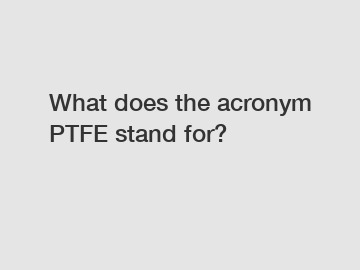Jan. 12, 2024
Rubber & Plastics
What does the acronym PTFE stand for?
PTFE, the acronym that stands for polytetrafluoroethylene, is a fascinating material known for its remarkable properties and versatile applications. From non-stick cookware to electrical insulation, PTFE has emerged as a game-changer in various industries. In this article, we will delve into the world of PTFE, exploring its origin, characteristics, applications, and more. So, let's dive right in!
Origin and Composition of PTFE:

1. Carbon and Fluorine Bonding: PTFE is a synthetic fluoropolymer of tetrafluoroethylene, comprising carbon and fluorine atoms. Renowned chemist Roy Plunkett discovered this compound accidentally in 1938 while working for DuPont.
2. Strong Carbon-Fluorine Bond: The strength of the carbon-fluorine bond in PTFE is what sets it apart from other materials. This strong bond makes the material highly resistant to chemicals, heat, and electricity, offering unparalleled durability.
Properties of PTFE:
1. Excellent Non-Stick Capability: PTFE is famous for its non-stick properties, making it ideal for cookware, such as frying pans and baking sheets. This characteristic prevents food particles from sticking, allowing for easy cleaning and hassle-free cooking.
2. High Heat Resistance: PTFE can withstand extreme temperatures ranging from -200°C to +260°C (-328°F to +500°F) without degradation. This heat resistance makes it suitable for various applications, including electrical insulation and high-temperature gaskets.
3. Chemical Inertness: PTFE exhibits exceptional resistance to chemicals, including acids, bases, and solvents. This property makes it indispensable in the chemical industry, where it is used for lining pipes, valves, and containers.
4. Low Friction Coefficient: Another remarkable feature of PTFE is its low friction coefficient. This property reduces friction between moving parts, making it ideal for applications such as bearings, seals, and conveyor belts.
Applications of PTFE:
1. Industrial Applications: PTFE finds widespread use in industries such as automotive, aerospace, and manufacturing. It is utilized as a lubricant, insulator, and sealant in various equipment and machinery. Additionally, PTFE coatings are applied to prevent corrosion and reduce wear and tear.
2. Medical Applications: PTFE's biocompatibility and non-reactivity make it suitable for medical applications. It is commonly used in surgical implants, catheters, and as a non-stick lining for medical equipment.
3. Electrical and Electronic Applications: Due to its excellent electrical insulation properties, PTFE is extensively used in the electrical and electronics industry. It serves as an insulating material for wires, cables, and connectors.
4. Coatings and Fabric Impregnation: PTFE coatings are widely utilized to provide a non-stick surface to cookware, bakeware, and electrical connectors. Moreover, it is used for fabric impregnation to make it resistant to stains and liquids.
Conclusion:
In conclusion, PTFE, or polytetrafluoroethylene, is a versatile material with remarkable properties that have revolutionized various industries. Its excellent non-stick capability, high heat resistance, chemical inertness, and low friction coefficient make it a sought-after material for a wide range of applications. Whether it's in the kitchen, the medical field, or electrical engineering, PTFE has proven its worth time and again. So, the next time you come across the acronym PTFE, you can confidently say that it stands for polytetrafluoroethylene!
For more information, please visit ptfe sheet supplier, 2mm ptfe sheet, teflon sheet manufacturer.
If you are interested in sending in a Guest Blogger Submission,welcome to write for us!
All Comments ( 0 )